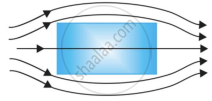Advertisements
Advertisements
Question
Answer in brief.
Discuss the Curie law for paramagnetic material.
Solution
Curie's law: The magnetization of a paramagnetic material is directly proportional to the external magnetic field and inversely proportional to the absolute temperature of the material.
If a paramagnetic material at an absolute temperature T is placed in an external magnetic field of induction `vec "B"_"ext"`, the magnitude of its magnetization
`"M"_"z" prop "B"_"ext"/"T"`
∴ `"M"_"z" = "C" "B"_"ext"/"T"`
where the proportionality constant C is called the Curie constant.
RELATED QUESTIONS
Give any ‘two’ points of differences between diamagnetic and ferromagnetic substances.
In what way is the behaviour of a diamagnetic material different from that of a paramagnetic, when kept in an external magnetic field?
Distinguish between diamagnetic and paramagnetic substances
The magnetic susceptibility of annealed iron at saturation is 4224. Find the permeability of
annealed iron at saturation. (μ0 = 4Π × 10−7 SI unit)
Explain Curie’s law for a paramagnetic substance.
Which of the following substances are diamagnetic?
Bi, Al, Na, Cu, Ca and Ni
The susceptibility of a magnetic material is − 2.6 × 10−5. Identify the type of magnetic material and state its two properties.
Draw magnetic field line when a (i) diamagnetic, (ii) paramagnetic substance is placed in an external magnetic field. Which magnetic property distinguishes this behaviour of the field line due to the substances?
Identify the following magnetic materials :
Which of the following statements is correct for diamagnetic materials?
For a paramagnetic substance, the magnetic susceptibility is ______.
The susceptibility of a magnetic material is positive and small. The material is ______.
The magnetic susceptibility of a paramagnetic material at - 73 °C is 0.0075. Its value at -173 °C will be ______.
All atoms of a magnetic substance have a resultant magnetic moment even in absence of external magnetic field. The substance is ______.
Magnetization of the sample is ______.
If a magnetic field is applied to a liquid in one arm of a narrow U-tube, the liquid level in that arm is lowered. The liquid in U-tube arm is ______.
Relative permittivity and permeability of a material are `epsilon_"r"` and `µ_"r"` respectively. Which of the following values of these quantities are allowed for a diamagnetic material?
The materials having negative magnetic susceptibility are ____________.
The magnetic property of magnetic substance is associated with ____________.
Above the curie temperature the susceptibility of ferromagnetic substance varies ____________.
A sphere of gold when brought towards a powerful magnet experiences ____________.
A small quantity of paramagnetic liquid is taken in a watch - glass and kept on two dissimilar magnetic poles. The liquid ____________.
A short bar magnet has a magnetic moment of 0.48 J T−1. Give the direction and magnitude of the magnetic field produced by the magnet at a distance of 10 cm from the centre of the magnet on
- the axis,
- the equatorial lines (normal bisector) of the magnet.
Why is diamagnetism, in contrast, almost independent of temperature?
Magnetic field lines are always nearly normal to the surface of a ferromagnet at every point. (This fact is analogous to the static electric field lines being normal to the surface of a conductor at every point.) Why?
A certain region of space is to be shielded from magnetic fields. Suggest a method.
A Rowland ring of mean radius 15 cm has 3500 turns of wire wound on a ferromagnetic core of relative permeability 800. What is the magnetic field B in the core for a magnetising current of 1.2 A?
The given figure represents a material which is ______.

Assertion: The ferromagnetic substance do not obey Curie’s law.
Reason: At Curie point a ferromagnetic substance start behaving as a paramagnetic substance.
Which of the following property shows the property of ferromagnetic substances?
When a ferromagnetic material is created above its curie temperature
Earth's magnetic field analyses has a horizontal component except at:-
A hydrogen atom is paramagnetic. A hydrogen molecule is
If a charged particle at rest experience no electromagnetic force
The universal property of all substances is ______.
According to the Atomic theory, on heating a magnet, the thermal energy of the elementary magnet ______
A paramagnetic sample shows a net magnetisation of 8 Am–1 when placed in an external magnetic field of 0.6 T at a temperature of 4 K. When the same sample is placed in an external magnetic field of 0.2 T at a temperature of 16 K, the magnetisation will be ______.
A permanent magnet in the shape of a thin cylinder of length 10 cm has M = 106 A/m. Calculate the magnetisation current IM.
Explain quantitatively the order of magnitude difference between the diamagnetic susceptibility of N2 (~5 × 10–9) (at STP) and Cu (~10–5).
A uniform magnetic field gets modified as shown in figure when two specimens A and B are placed in it.
 |
 |
| (a) | (b) |
- Identify the specimen A and B.
- How is the magnetic susceptibility of specimen A different from that of specimen B?
Magnetic susceptibility for a paramagnetic and diamagnetic materials is respectively ______.
An ammeter of resistance R gives a full-scale deflection when a current of 2 A passes through it. If it is measured with a maximum current of 10 A, the required shunt is ______.
Which of the following cannot modify an external magnetic field as shown in the figure?

State the dimensions of magnetization.
Magnetic susceptibility of a diamagnetic substance ______.
